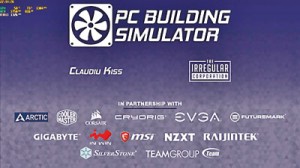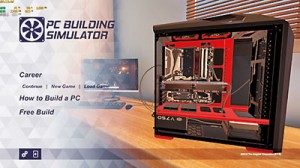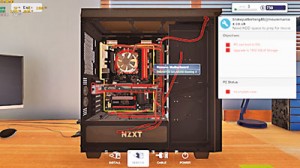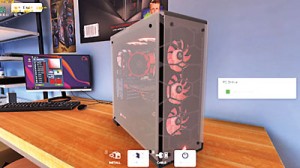Using a PC building Simulator
If you are yet to build your first PCit might seem like a daunting task. This is where PC Building Simulator comes to the rescue. As the name suggests, it is exactly that. A simulator to build PCs.
Setting things up
Available via Steam’s early access for around $20 which equals around LKR 3,100/the game is around 800MB in size and can be launched by the shortcut created when installing the game through steam. The game’s loading screen is a collage of brands such as Corsair, EVGA, MSI, Gigabyte, Asus, Cooler Master and NZXT. This means that once you’re done building your PC, it will pretty much look like it would in the real world.

Building your dream PC
PC Building Simulator has two main modes. The career mode and free build mode. The career mode essentially puts you in charge of your own workshop where customers will bring you their PCs to diagnose and repair. This can range from a simple virus scan, to replacing faulty components, to actually building PCs according to the customer’s specification later on.
Each job you complete not only gives you cash, but also gives you XP points that you can use to level up. Leveling up gives you access to more components which you can use in your career. Communication with customers is done via email. The shopping platform is used to order components that you would need to repair customer PCs.
When ordering components, you can choose to have them delivered immediately, the next day or within 3-5 days. This adds a depth of realism to the game as your choice can affect the customer as well. It’s essentially you managing a real PC repair and hardware store.
Gameplay is pretty easy
The controls are pretty easy to get used to. Using the WASD keys, you can walk over to a PC, pick it up and then place it on a workbench. From there, you can install components, remove components and attach cables. Hovering over each component will tell you the component name along with its brand name and model.
As the days go on, (by walking towards the door and ending your shift at work), the jobs will also get more complicated. You will also need to use some logic and marketing skills to make sure components arrive in time. As an example, running a virus scan on a PC will take a lot less time than replacing a graphics card (even though it might be the inverse in real life situations).

It’s just like fixing a real PC
Just like in the real world, PC Building Simulator is rather methodical about installing and removing components in a PC. You can’t just select the Motherboard, and replace it with a new one. There’s a method to the madness. You have to unplug all the cables, remove all the components and the screws holding them in place and then replace the faulty component. A check box on the right side of the screen lists down your objectives. Red means you haven’t met the objective and Green means you’re good to go.
On the other hand, if you have not connected any cables, or not applied thermal paste (which apparently you have to do each time you take out the CPU cooler), the PC will not boot until you attach the said cable or reapply the thermal paste. It’s annoying at times, but actually will make you a better system builder in the long run.
Once your work is over and all the PCs for the day have been fixed and are awaiting pickup, you can head over to your own PC to collect the payment for said PCs.
Similarly, if a customer drops off a PC saying it will be collected in 6-7 days and there are two other PCs that need to be fixed by tomorrow, the logical choice would be to fix the PCs that need immediate attention. If you are skilled enough, you can actually get a list of all the components that need to be ordered from all the PCs, put them all into one order and ship it. Of course, you’ll need to have sufficient funds to do that as well.
Letting that creativeness fly
If you’re looking for a break from answering to the needs and wants of customers, you can take a moment for yourself and indulge in some PC building of your own. This is done via the “Free Build” mode. Think of it as an all access pass to the workshop where you have all components at your disposal.

In Conclusion
Overall, PC Building Simulator is a fun game, if you’re willing to pay attention and you have a passion for building (or repairing PCs). One thing that I should give props to is the level of detail that the developers have gone into to make all the components look as accurate to their real life counterparts as possible. Once you zoom into a motherboard or a chassis, you see the little screw holes and the ports on the motherboard as accurately as you would on a real motherboard.
It does have its cons though. For starters, the music tends to be quite repetitive.
Also, the game does require a moderately powerful graphics card to turn on all the bells and whistles. Once you do, the game does look amazing.
If you’re looking to build your first PC and you’re not sure of how it will look, you can try the PC Building Simulator. It’s quite addictive once you start playing around with all the components and how they look. On the other hand, if you want to see what it’s like to run your own PC workshop, this would also be a good opportunity to get a basic understanding of how your favorite PC store operates.
(The author is senior tech writer for readme.lk, a leading provider of technology news. visit readme.lk for more information).


